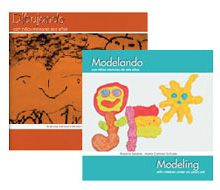ExchangeEveryDay Past Issues
 << Previous Issue
| View Past Issues | | Next Issue >>
<< Previous Issue
| View Past Issues | | Next Issue >> -Josh Billings
"....We realised that we needed to provide alternatives for what we did not have. For example, where we did not have tables, we had flat areas of earth; where we did not have pencils, we had branches and charcoal; where we did not have white papers, we had old newspapers and flat stones; where we did not have colours, we had plants, flowers, fruits and soil; and where we did not have teachers, we had mothers and young community volunteers. The constant was, however, that we always have children who want to live, to learn, and to dream. We discovered that the transcendental value of living was strongly rooted despite the lack of materials in this urban or rural poverty context...
"In short, this situation motivated us to begin looking for alternatives and real possibilities, and to promote sustained creativity in the minds of the children and the community educators. The situation of poverty should not paralyze our aspirations and the integral development of our children. On the contrary, we found that the context of poverty was the genuine source of our liberation. In that web of miseries and ventures, we were able to find solutions by using what was in the environment. This comprised of three components:
- Social component: we had families who were of very low income and few material possessions, but who were willing to participate extensively.
- Nature component: we had a beautiful and mysterious landscape of mountains, forests, and rivers with their different climates.
- Cultural component: we had languages, traditions, legends, dances, songs, and art.
 You'll save 20% when you purchase both Dibujando / Drawing with Children and Modelando / Modeling with children under six years old (regularly $10 each).
You'll save 20% when you purchase both Dibujando / Drawing with Children and Modelando / Modeling with children under six years old (regularly $10 each).
Dibujando con Niños / Drawing with Children
Authors, Roxana Salazar and Maria Carmen Schulze, describe in words (English and Spanish) and photos their work in Bolivia teaching children to draw using elements in their natural environment. This short (24 pages) book combines both a theoretical framework as well as real life examples, woven together by the amazing passion of the authors.
Modelando con ninos menores de seis anos / Modeling with children under six years old
Children represent their understandings and develop hypotheses through modeling with clay. Stunning photography and text in English and Spanish share the authors' premise that children can learn and express themselves through materials, given the nurturing of adults who see the possibilities in the resources and the potential of each child.
ExchangeEveryDay
Delivered five days a week containing news, success stories, solutions, trend reports, and much more.
What is ExchangeEveryDay?
ExchangeEveryDay is the official electronic newsletter for Exchange Press. It is delivered five days a week containing news stories, success stories, solutions, trend reports, and much more.

Jonti-Craft® products are now GREENGUARD Children & SchoolsSM Certified® and GREENGUARD Indoor Air Quality Certified®. When customers buy Jonti-Craft products, they know they are contributing to healthier indoor air quality.


Comments (3)
Displaying All 3 CommentsSt. Raphael Speech and Special Education Services
Manila, Philippines
I find the article very refreshing. Thank you for sharing it to me, Dr. Carolyn Ronquillo.
God bless,
Maria Pamela B. Primero - Magpily
Shrewsbury, NJ, United States
Very Inspiring! The value of materials validated in a most profound way also the importance of identity derived from place. Wonderful!
SPCCC, Inc.
Potsdam, NY, United States
I loved this article. It's so true. You have to be a resourceful teacher and make the most of the resources available to you. Sometimes it takes creative thought and a grateful heart to see the untapped potential that surrounds us.
Post a Comment